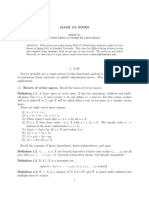Tutorial Problem Set-II
Tutorial Problem Set-II
Uploaded by
aayush.5.parasharCopyright:
Available Formats
Tutorial Problem Set-II
Tutorial Problem Set-II
Uploaded by
aayush.5.parasharCopyright
Available Formats
Share this document
Did you find this document useful?
Is this content inappropriate?
Copyright:
Available Formats
Tutorial Problem Set-II
Tutorial Problem Set-II
Uploaded by
aayush.5.parasharCopyright:
Available Formats
spanda@maths.iitkgp.ac.
in 1
Tutorial Problems set-II
Note: All these problems can be solved using the results of Chapter-2.
n
P
[0.0.1] Exercise Find a necessary and sufficient condition for hx, yi = αi xi yi to be an inner product
i=1
on Rn .
!
a11 a12
[0.0.2] Exercise Let A = be a 2 × 2 matrix with real entries. Let fA : R2 → R be a map
a21 a22
defined by fA (x, y) = y t Ax, where x, y ∈ R2 . Show that fA is an inner product on R2 if and only if
A = At , a11 > 0, a22 > 0 and det(A) > 0.
[0.0.3] Exercise Let V be a finite-dimensional vector space and let B = {u1 , . . . , un } be a basis for V.
Let hx, yi be an inner product on V. If c1 , . . . , cn are any n scalars, show that there is exactly one
vector x in V such that hx, u1 i = ci for i = 1, . . . , n.
[0.0.4] Exercise Let (V, h, i) be an inner product space. Show that hx, yi = 0 for all y ∈ V, then x = 0.
n
xi yi is not an inner product on Cn .
P
[0.0.5] Exercise Show that hx, yi =
i=1
[0.0.6] Exercise Let (V, h, i) be a finite inner product space. Prove that for v ∈ V − {0}, the set
W = {w ∈ V : hw, vi = 0} is a subspace of V of dimension dim V − 1.
[0.0.7] Exercise Decide which of the following functions define an inner product C2 . For x = (x1 , y1 ),
y = (y1 , y2 ).
1. hx, yi = x1 y2
2. hx, yi = x1 y1 + x2 y2
3. hx, yi = x1 y1 + x2 y2
4. hx, yi = 2x1 y1 + i(x2 y1 − x1 y2 ) + 2x2 y2
[0.0.8] Exercise Let VP3 (x) be a subspace of real polynomials of degree at most 3. Equip V with the
inner product
Z1
hf, gi = f (x)g(x)dx
0
.
1. Find the orthogonal complement of the subspace of scalar polynomials.
2. Apply the Gram Schmidt process to the basis {1, x, x2 , x3 }.
[0.0.9] Exercise Find an inner product on R2 such that he1 , e2 i = 2.
spanda@maths.iitkgp.ac.in 2
[0.0.10] Exercise Let V be the space of all n × n over R with the inner product hA, Bi = trace(AB t ).
Find the orthogonal complement of the subspaces of diagonal matrices.
[0.0.11] Exercise Let (V, h, i) be an IPS. Let α, β ∈ V. Then show that α = β if and only if hα, γi =
hβ, γi for all γ ∈ V.
[0.0.12] Exercise Apply Gram Schmidt process to the vectors u1 = (1, 0, 1), u2 = (1, 0, −1) and u3 =
(0, 3, 4) to obtain an orthonormal basis for R2 with the standard inner product.
2 1 −1
t 2
[0.0.13] Exercise Consider the inner product hx, yi = y AX on R where A = 1 1 0 . Find an
−1 0 3
orthonormal basis B of S := {(x1 , x2 , x3 ) : x1 + x2 + x3 = 0} and then extend it to an orthonormal
basis of R3 .
p
[0.0.14] Exercise Let (V, h, i) be an IPS. Let ||u|| = hu, ui for all u ∈ V be the norm induced by h, i.
Then prove that ||u + v||2 + ||u − v||2 = 2||u||2 + 2||v||2 .
[0.0.15] Exercise Let (V, h, i) be a finite dimensional IPS. Let B = {u1 , u2 , . . . , un } be a basis of V. Then
prove that hu, vi = ȳ t Ax for all u, v ∈ V where x = (x1 , . . . , xn )t ,y = (y1 , . . . , yn )t are coordinates of
u and v with respect to basis B and aij = hui , uj i.
You might also like
- Assignment 1: CMSC 498L Released: Feb-14. Due Feb-21Document2 pagesAssignment 1: CMSC 498L Released: Feb-14. Due Feb-21Zu KiNo ratings yet
- Xenogears Official Strategy Guide - Text PDFDocument227 pagesXenogears Official Strategy Guide - Text PDFZhong Shi50% (2)
- FS Episode 8Document18 pagesFS Episode 8Abegail Linaga93% (104)
- Stnote131 116 ch6 PDFDocument36 pagesStnote131 116 ch6 PDFMuhammad Gabdika BayubuanaNo ratings yet
- The Curriculum: Different Dimensions The Traditional Versus Modern Dimension of The CurriculumDocument2 pagesThe Curriculum: Different Dimensions The Traditional Versus Modern Dimension of The CurriculumML Almodiel100% (10)
- Illustrated Notes-Form One and Two NotesDocument131 pagesIllustrated Notes-Form One and Two NotesDi'genius Neshmentation100% (3)
- Summary of Roe VDocument17 pagesSummary of Roe Vsheila_01No ratings yet
- Lectura 4 - KPMG Avoiding Major Project FailureDocument8 pagesLectura 4 - KPMG Avoiding Major Project FailureMayra GálvezNo ratings yet
- Solution of Tutorial Problems Set-IIDocument7 pagesSolution of Tutorial Problems Set-IIaayush.5.parasharNo ratings yet
- Linear Algebra Inner ProductDocument3 pagesLinear Algebra Inner ProductkamleshNo ratings yet
- Unit-4 - Inner Product SpaceDocument19 pagesUnit-4 - Inner Product Spacekowshik.annavarapuNo ratings yet
- Chap 1Document28 pagesChap 1Steve ClarkNo ratings yet
- Tutorial Sheet No. 5: 1 2 N N I IDocument1 pageTutorial Sheet No. 5: 1 2 N N I IKishan PatelNo ratings yet
- Week13 14Document21 pagesWeek13 14Abdurrahman HazerNo ratings yet
- Problem Set 5Document2 pagesProblem Set 5Anushka VijayNo ratings yet
- MTL101-Tutorial Sheet 3Document2 pagesMTL101-Tutorial Sheet 3Mohammad AnsarNo ratings yet
- MTL101-Tutorial Sheet 2Document2 pagesMTL101-Tutorial Sheet 2Mridul JagratNo ratings yet
- FA Chap4 1-4 PDFDocument4 pagesFA Chap4 1-4 PDFJuan Carlos Moreno OrtizNo ratings yet
- Rango Nulidad y OtrosDocument9 pagesRango Nulidad y OtrosKevin Carrillo ReinaNo ratings yet
- Hilbert 3Document35 pagesHilbert 3HadeelAl-hamaamNo ratings yet
- Assignment I Sem VDocument1 pageAssignment I Sem VABCSDFGNo ratings yet
- Math6338 hw1Document5 pagesMath6338 hw1Ricardo E.No ratings yet
- MAI 102 Assignment 3Document3 pagesMAI 102 Assignment 3ar.devpareekNo ratings yet
- MAI 102 Assignment 3 - 240214 - 233830Document22 pagesMAI 102 Assignment 3 - 240214 - 233830Sarita GuptaNo ratings yet
- 5.4 Inner Product SpacesDocument10 pages5.4 Inner Product SpacesLinaNo ratings yet
- Section 6.1 - Inner Products and Norms: M×N I, J I, JDocument16 pagesSection 6.1 - Inner Products and Norms: M×N I, J I, JMarcos Alberto VieraNo ratings yet
- Brief Introduction To Hilbert SpaceDocument9 pagesBrief Introduction To Hilbert SpaceΧάρης Φραντζικινάκης100% (2)
- Inner PDFDocument15 pagesInner PDFT BlackNo ratings yet
- Tutorial Problem IDocument2 pagesTutorial Problem Iaayush.5.parasharNo ratings yet
- 7 PDFDocument4 pages7 PDFjohanNo ratings yet
- Ph.D. Qualifying Examination, Real Analysis Spring 2006,: N P N P N N P 1 NDocument2 pagesPh.D. Qualifying Examination, Real Analysis Spring 2006,: N P N P N N P 1 NpaimoNo ratings yet
- Inner Product SpaceDocument32 pagesInner Product Spacethuannm0426No ratings yet
- MA 111 Endsem@Part-ADocument1 pageMA 111 Endsem@Part-AVishal SinghNo ratings yet
- Assignment 2: Attempt All QuestionsDocument1 pageAssignment 2: Attempt All QuestionsbailajkhanjavedNo ratings yet
- Assignment 2Document2 pagesAssignment 2utpal singhNo ratings yet
- Tut Sheet 3Document2 pagesTut Sheet 3iamanay17No ratings yet
- MidtermDocument1 pageMidterm3dd2ef652ed6f7No ratings yet
- Assignment 1Document5 pagesAssignment 1ma22c026No ratings yet
- Innerproduct PrintDocument10 pagesInnerproduct PrintLuthHeldzistNo ratings yet
- Mso Ques SLDocument10 pagesMso Ques SLsddsdsdNo ratings yet
- MA201 - Tutorial Sheet-3Document1 pageMA201 - Tutorial Sheet-3Mayank SinghNo ratings yet
- HW Apr 5 SolsDocument4 pagesHW Apr 5 Solselvisproductions889No ratings yet
- Sheet1 MT2022Document2 pagesSheet1 MT2022aknx143No ratings yet
- Pde PDFDocument2 pagesPde PDFJoseph KfouryNo ratings yet
- Homework 3: X Z Y W X×Y X YDocument2 pagesHomework 3: X Z Y W X×Y X YLuis EduardoNo ratings yet
- Towards The Cauchy Problem For TheDocument18 pagesTowards The Cauchy Problem For Theashraf shalghoumNo ratings yet
- Lecture Notes W2Document9 pagesLecture Notes W2Lilach NNo ratings yet
- Linear Algebra Demystified Ch6Document15 pagesLinear Algebra Demystified Ch6Rajib BaruaNo ratings yet
- Tutorial ProblemsDocument3 pagesTutorial ProblemsNoob ShuklajiNo ratings yet
- 20122: Starter Problems 1-6Document1 page20122: Starter Problems 1-6PiNo ratings yet
- Examples 1Document2 pagesExamples 1SonozixNo ratings yet
- 1 ProjectDocument4 pages1 Projectjanecoco0222No ratings yet
- HOMEWORK2Document2 pagesHOMEWORK2Alvarez JulioNo ratings yet
- Examen 2022Document3 pagesExamen 2022camillou.beckNo ratings yet
- Section 6.1 Linear BDocument13 pagesSection 6.1 Linear BNonsikelelo GobozaNo ratings yet
- Matrix Calculus4mlDocument20 pagesMatrix Calculus4mlAlmog BendaNo ratings yet
- MAST10008 Accelerated Mathematics 1Document1 pageMAST10008 Accelerated Mathematics 1Cindy DingNo ratings yet
- 175 MainDocument60 pages175 Mainmyturtle game01No ratings yet
- Aronszajn's Theorem: X X X X XDocument4 pagesAronszajn's Theorem: X X X X X김용성No ratings yet
- Indian Forest Service (IFoS-IFS) Mains Exam Maths Optional Real Analysis Previous Year Questions (PYQs) From 2020 To 2009Document6 pagesIndian Forest Service (IFoS-IFS) Mains Exam Maths Optional Real Analysis Previous Year Questions (PYQs) From 2020 To 2009BarnedNo ratings yet
- Math Review For MLDocument41 pagesMath Review For MLVincent ChungNo ratings yet
- Functional Analysis2Document173 pagesFunctional Analysis2boris peñaNo ratings yet
- Homework 1Document3 pagesHomework 1Anh HoangNo ratings yet
- Sheet - Functions VibrantDocument32 pagesSheet - Functions VibrantKriti PriyaNo ratings yet
- 20T1 PMTH331 Tutorial 5 PDFDocument1 page20T1 PMTH331 Tutorial 5 PDFJeremy J. HoffmanNo ratings yet
- Hyperbolic Functions (Trigonometry) Mathematics E-Book For Public ExamsFrom EverandHyperbolic Functions (Trigonometry) Mathematics E-Book For Public ExamsNo ratings yet
- Steel Solutions User GuideDocument32 pagesSteel Solutions User GuideCraciun PaulNo ratings yet
- Tamminen Tuire Dissertation 2020Document118 pagesTamminen Tuire Dissertation 2020Carolina Duque RodriguezNo ratings yet
- Svamitva - Guidelines - (2021-2025)Document102 pagesSvamitva - Guidelines - (2021-2025)sandeep kumarNo ratings yet
- Anthropometry and Clothing ConstructionDocument9 pagesAnthropometry and Clothing ConstructionAsif MangatNo ratings yet
- AEF3 - Part of WorksheetDocument1 pageAEF3 - Part of WorksheetReza EsfandiariNo ratings yet
- Regna Et Gentes, Ed. H. W. Goetz, J. Jarnut, W. Pohl (2003) - Part54Document10 pagesRegna Et Gentes, Ed. H. W. Goetz, J. Jarnut, W. Pohl (2003) - Part54Radjar KiplingNo ratings yet
- Buting Senior High School Media and Information Literacy Unit TestDocument2 pagesButing Senior High School Media and Information Literacy Unit TestGina BundaNo ratings yet
- Lifting Appliances Guide Jun20Document244 pagesLifting Appliances Guide Jun20cnl filesNo ratings yet
- Nursing Care PlanDocument3 pagesNursing Care PlanBhie DizonNo ratings yet
- Gift From Wild-WPS OfficeDocument2 pagesGift From Wild-WPS OfficeJaemyhunNo ratings yet
- Once Upon A Time in A Small Town Named AtomvilleDocument4 pagesOnce Upon A Time in A Small Town Named AtomvilleDianne AgustinNo ratings yet
- We Are Gathering TogetherDocument1 pageWe Are Gathering TogetherAdeyemi JosephNo ratings yet
- Against War: A Book in The SeriesDocument354 pagesAgainst War: A Book in The SeriescontatomenezesheitorNo ratings yet
- Certificate in Quantity Surveying Practice: Course SummaryDocument3 pagesCertificate in Quantity Surveying Practice: Course SummaryBuildTech CivilNo ratings yet
- Health Assessment Questionnaire-English NEW-1Document4 pagesHealth Assessment Questionnaire-English NEW-1intan syolendraNo ratings yet
- Lipid Metabolism Quize PDFDocument5 pagesLipid Metabolism Quize PDFMadani TawfeeqNo ratings yet
- IFMA FMPv3-0 F-B Ch4Document46 pagesIFMA FMPv3-0 F-B Ch4Mohamed IbrahimNo ratings yet
- Error Amplifier Ics (Se Series)Document1 pageError Amplifier Ics (Se Series)klaus allowsNo ratings yet
- 20MnCr5 Chromium-Manganese Case Hardening Steel - Hillfoot Multi MetalsDocument1 page20MnCr5 Chromium-Manganese Case Hardening Steel - Hillfoot Multi MetalsAnonymous 1iojHt3No ratings yet
- GP SheetDocument14 pagesGP SheetAyan RazaNo ratings yet
- A Qualitative Study On Life Adjustment of Working Student Who Are Experiencing PovertyDocument20 pagesA Qualitative Study On Life Adjustment of Working Student Who Are Experiencing PovertyDanica Ormeo IIINo ratings yet
- Three Vignettes in Mixed StyleDocument29 pagesThree Vignettes in Mixed StyleavadhanulakNo ratings yet
- LogDocument27 pagesLogchaaanrikkaNo ratings yet
- Amc Junior 2009Document9 pagesAmc Junior 2009Bai LiNo ratings yet

























































































